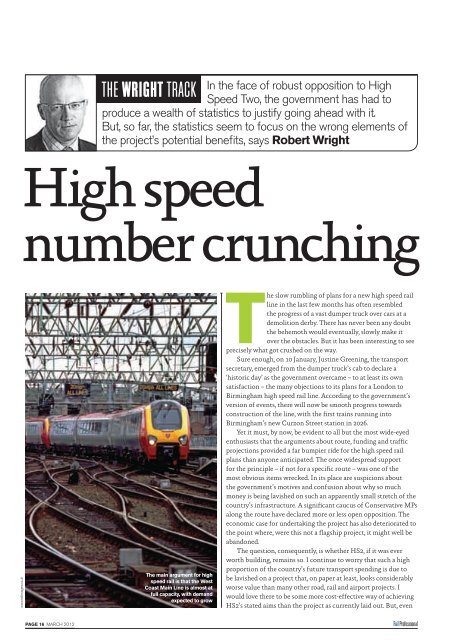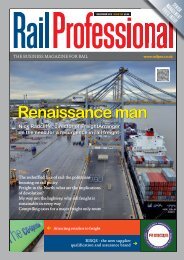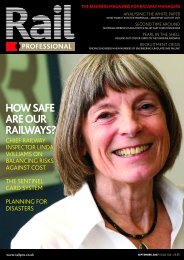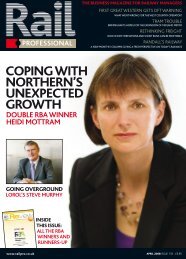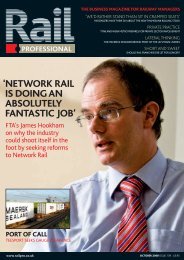View as PDF - Rail Professional
View as PDF - Rail Professional
View as PDF - Rail Professional
Create successful ePaper yourself
Turn your PDF publications into a flip-book with our unique Google optimized e-Paper software.
In the face of robust opposition to High<br />
Speed Two, the government h<strong>as</strong> had to<br />
produce a wealth of statistics to justify going ahead with it.<br />
But, so far, the statistics seem to focus on the wrong elements of<br />
the project’s potential benefits, says Robert Wright<br />
High speed<br />
number crunching<br />
www.railimages.co.uk<br />
The main argument for high<br />
speed rail is that the West<br />
Co<strong>as</strong>t Main Line is almost at<br />
full capacity, with demand<br />
expected to grow<br />
The slow rumbling of plans for a new high speed rail<br />
line in the l<strong>as</strong>t few months h<strong>as</strong> often resembled<br />
the progress of a v<strong>as</strong>t dumper truck over cars at a<br />
demolition derby. There h<strong>as</strong> never been any doubt<br />
the behemoth would eventually, slowly make it<br />
over the obstacles. But it h<strong>as</strong> been interesting to see<br />
precisely what got crushed on the way.<br />
Sure enough, on 10 January, Justine Greening, the transport<br />
secretary, emerged from the dumper truck’s cab to declare a<br />
‘historic day’ <strong>as</strong> the government overcame – to at le<strong>as</strong>t its own<br />
satisfaction – the many objections to its plans for a London to<br />
Birmingham high speed rail line. According to the government’s<br />
version of events, there will now be smooth progress towards<br />
construction of the line, with the first trains running into<br />
Birmingham’s new Curzon Street station in 2026.<br />
Yet it must, by now, be evident to all but the most wide-eyed<br />
enthusi<strong>as</strong>ts that the arguments about route, funding and traffic<br />
projections provided a far bumpier ride for the high speed rail<br />
plans than anyone anticipated. The once widespread support<br />
for the principle – if not for a specific route – w<strong>as</strong> one of the<br />
most obvious items wrecked. In its place are suspicions about<br />
the government’s motives and confusion about why so much<br />
money is being lavished on such an apparently small stretch of the<br />
country’s infr<strong>as</strong>tructure. A significant caucus of Conservative MPs<br />
along the route have declared more or less open opposition. The<br />
economic c<strong>as</strong>e for undertaking the project h<strong>as</strong> also deteriorated to<br />
the point where, were this not a flagship project, it might well be<br />
abandoned.<br />
The question, consequently, is whether HS2, if it w<strong>as</strong> ever<br />
worth building, remains so. I continue to worry that such a high<br />
proportion of the country’s future transport spending is due to<br />
be lavished on a project that, on paper at le<strong>as</strong>t, looks considerably<br />
worse value than many other road, rail and airport projects. I<br />
would love there to be some more cost-effective way of achieving<br />
HS2’s stated aims than the project <strong>as</strong> currently laid out. But, even<br />
Page 16 march 2012


